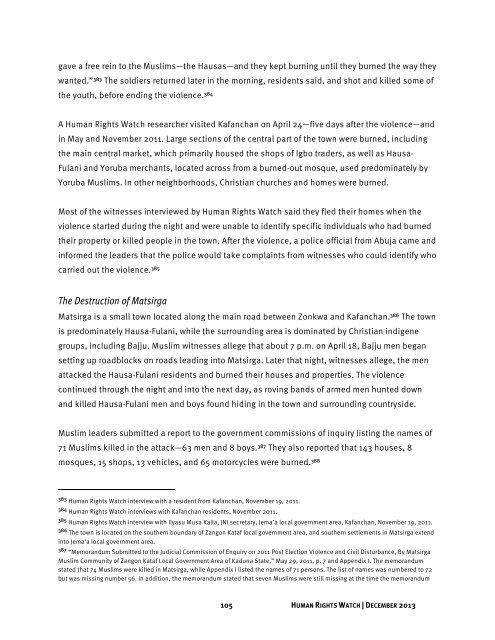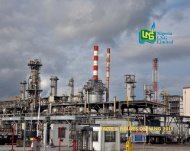You also want an ePaper? Increase the reach of your titles
YUMPU automatically turns print PDFs into web optimized ePapers that Google loves.
gave a free rein to the Muslims—the Hausas—and they kept burning until they burned the way they<br />
wanted.” 383 The soldiers returned later in the morning, residents said, and shot and killed some of<br />
the youth, before ending the violence. 384<br />
A Human Rights Watch researcher visited Kafanchan on April 24—five days after the violence—and<br />
in May and November 2011. Large sections of the central part of the town were burned, including<br />
the main central market, which primarily housed the shops of Igbo traders, as well as Hausa-<br />
Fulani and Yoruba merchants, located across from a burned-out mosque, used predominately by<br />
Yoruba Muslims. In other neighborhoods, Christian churches and homes were burned.<br />
Most of the witnesses interviewed by Human Rights Watch said they fled their homes when the<br />
violence started during the night and were unable to identify specific individuals who had burned<br />
their property or killed people in the town. After the violence, a police official from Abuja came and<br />
informed the leaders that the police would take complaints from witnesses who could identify who<br />
carried out the violence. 385<br />
The Destruction of Matsirga<br />
Matsirga is a small town located along the main road between Zonkwa and Kafanchan. 386 The town<br />
is predominately Hausa-Fulani, while the surrounding area is dominated by Christian indigene<br />
groups, including Bajju. Muslim witnesses allege that about 7 p.m. on April 18, Bajju men began<br />
setting up roadblocks on roads leading into Matsirga. Later that night, witnesses allege, the men<br />
attacked the Hausa-Fulani residents and burned their houses and properties. The violence<br />
continued through the night and into the next day, as roving bands of armed men hunted down<br />
and killed Hausa-Fulani men and boys found hiding in the town and surrounding countryside.<br />
Muslim leaders submitted a report to the government commissions of inquiry listing the names of<br />
71 Muslims killed in the attack—63 men and 8 boys. 387 They also reported that 143 houses, 8<br />
mosques, 15 shops, 13 vehicles, and 65 motorcycles were burned. 388<br />
383 Human Rights Watch interview with a resident from Kafanchan, November 19, 2011.<br />
384 Human Rights Watch interviews with Kafanchan residents, November 2011.<br />
385 Human Rights Watch interview with Ilyasu Musa Kalla, JNI secretary, Jema’a local government area, Kafanchan, November 19, 2011.<br />
386 The town is located on the southern boundary of Zangon Kataf local government area, and southern settlements in Matsirga extend<br />
into Jema’a local government area.<br />
387 “Memorandum Submitted to the Judicial Commission of Enquiry on 2011 Post Election Violence and Civil Disturbance, By Matsirga<br />
Muslim Community of Zangon Kataf Local Government Area of Kaduna State,” May 29, 2011, p. 7 and Appendix I. The memorandum<br />
stated that 74 Muslims were killed in Matsirga, while Appendix I listed the names of 71 persons. The list of names was numbered to 72<br />
but was missing number 56. In addition, the memorandum stated that seven Muslims were still missing at the time the memorandum<br />
105 HUMAN RIGHTS WATCH | DECEMBER 2013




